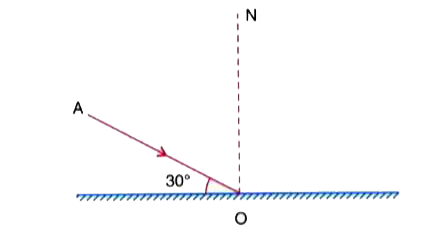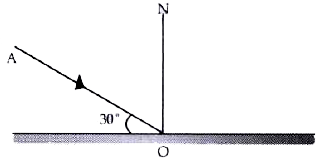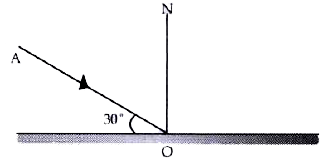The incident ray, the _______ ray and the normal lie in the same plane during refraction.
To solve the question, we need to identify the missing term that describes the ray involved in the process of refraction along with the incident ray and the normal.
1. Understand the Concept of Refraction: Refraction occurs when light travels from one medium to another and changes its speed, causing it to bend.
2. Identify the Rays Involved: In the process of refraction, there are three important components:
- The incident ray: This is the ray of light that strikes the boundary between two different media.
- The refracted ray: This is the ray of light that has passed into the second medium and is bent due to the change in speed.
- The normal: This is an imaginary line that is perpendicular to the surface at the point of incidence.
3. Recall the Law of Refraction: According to the law of refraction (Snell's Law), the incident ray, the refracted ray, and the normal line all lie in the same plane.
4. Fill in the Blank: The question asks for the missing term in the statement: "The incident ray, the _______ ray, and the normal lie in the same plane during refraction." The correct term to fill in the blank is "refracted".
Final Answer:
The incident ray, the refracted ray, and the normal lie in the same plane during refraction.
---
- The incident ray: This is the ray of light that strikes the boundary between two different media.
- The refracted ray: This is the ray of light that has passed into the second medium and is bent due to the change in speed.
- The normal: This is an imaginary line that is perpendicular to the surface at the point of incidence.
The incident ray, the refracted ray, and the normal lie in the same plane during refraction.
Topper's Solved these Questions
- BOOK - ICSECHAPTER - LIGHT ENERGYEXERCISE - EXERCISE-5.3 (Objective Type Questions) B. Statements given below are incorrect. Write the correct statements.5videos
LIGHT ENERGY
- BOOK - ICSECHAPTER - LIGHT ENERGYEXERCISE - EXERCISE-5.3 (Objective Type Questions) C. Write .true.of .false. for the following statements :5videos
LIGHT ENERGY
- BOOK - ICSECHAPTER - LIGHT ENERGYEXERCISE - EXERCISE 5.2 (STUDY QUESTIONS)4videos
LIGHT ENERGY
- BOOK - ICSECHAPTER - HEAT TRANSFER EXERCISE - Picture Study2videos
HEAT TRANSFER
- BOOK - ICSECHAPTER - MATTER EXERCISE - THEME ASSIGNMENT25videos
MATTER
Similar Questions
The incident ray, the reflected ray and the normal lie............
View SolutionDraw diagrams to show the refraction of light from (i) air to glass, and (ii) glass to air. In each diagram, label the incident ray, refracted ray, the angle of incidence (i) and the angle of refraction (r).
View SolutionDraw a diagram to show the reflection of a ray of light by a plane mirror. In the diagram, label the incident ray, the reflected ray, the normal, the angle of incidence and the angle of reflection.
View SolutionDraw a diagram showing the reflection of a light ray from a plane mirror. Label on it the incident ray, the reflected ray, the normal, the angle of incidence i and the angle of reflection r.
View SolutionExplain refraction. Draw a diagram and explain incident ray, refracted ray, angle of incidence, and angle of refraction.
View SolutionThe following diagram (Fig) shows an incident ray AO and the normal ON on a plane mirror. Find the angle of incidence and angle of reflection.
 View Solution
View SolutionIf a,b, and c are the unit vectors along the incident ray, reflected ray and the outward normal to the reflector. Then
View SolutionFig. shows an incident ray AO and the normal ON on a plane mirror. The angle which the incident ray AO makes with mirror is 30∘.
Draw the reflected ray
 View Solution
View SolutionFig. shows an incident ray AO and the normal ON on a plane mirror. The angle which the incident ray AO makes with mirror is 30∘.
Find the angle of incidence.
 View Solution
View SolutionDraw the incident ray and the reflected ray. if a light ray is incident on a plane mirror with the angle of incidence 30∘.
View Solution

